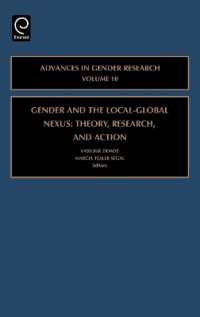Full Description
Moments & Movements: Counterstories for Critical Asian American Studies in Education is a collection of counterstories born from community and shared commitments to challenge the ways diverse diasporas and experiences of people from the Asian continent and the Pacific Ocean are largely made invisible, silenced, and erased. By defying reductionist narratives, the collection highlights stories built upon generations of struggle, resistance, advocacy, and joy, that impart wisdom for the current moment and for Asian American movements in the future, particularly movements based in education. The book's topics, located at the nexus of multiple and interconnected fields, such as education, race/ethnic studies, policy and community studies, have broad appeal to a cross-section of university academics; P-12 teachers and leaders; and community educators and activists.
Using the framing of Critical Asian American Studies, the chapters in this volume emphasize criticality as central to the work of educators committed to more just futures. The plus ( ) symbol in "Asian American " highlights the volume's efforts at diverse inclusion and openness to various groups under a broad umbrella geographic category, including voices of various Pasifika, Arab and Middle Eastern communities, without eliding their distinct histories, cultures, politics, and experiences or erasing the tensions within and across the broader category of Asian American studies.
The book is organized thematically into four sections that reflect key moments in an ongoing movement. This organization acknowledges that readers may be at different points in their journeys towards developing more critical perspectives or knowledge of Asian American, Arab/Middle Eastern American, and Pasifika peoples' experiences in education. The first section, "The Moment We Begin", focuses on foundational beginnings, telling stories of how the authors made important first steps in creating the change they wished to see in their educational spheres. The second section, "Building an Inclusive Movement", examines how educators sustain and deepen their work within and outside of classrooms. The third section, "Extending the Movement", then looks at Critical Asian American Studies outside of classrooms and schools by attending to educational leadership, families and teacher identities, policy arenas, and educational, cultural, and community activism. Finally, in the fourth section, "Envisioning New Worlds", chapters attend to what justice-focused, future-oriented movements might look like for Critical Asian American Studies.
All too often, critical community-grounded work can feel daunting. This collection pushes beyond prescribed borders that separate our communities and separate us into our own educational spheres (e.g. P-12, higher education, teacher education) and roles (professor, teacher, principal, student). As one of the few edited collections with such diverse perspectives, this collection provides multiple paths forward in Asian American, Arab/Middle Eastern American, and Pasifika Studies, inspires with its counterstories of struggle and success, and challenges readers to consider their own next steps.
Perfect for courses such as: Asian Americans in Education; Critical Studies in Education; Multicultural Education/Sociocultural Foundations in Education; Ethnic Studies/Asian American Studies; Social Justice in Education; Critical Pedagogy and Education; Urban Education; Race, Ethnicity, and Education; Introduction to Education; School and Society
Contents
Acknowledgments
Foreword - Kevin K. Kumashiro
Introduction: Moments and Movements: An Invitation to Build With Us
Betina Hsieh and Roland Sintos Coloma
Part One: The Moment We Begin
Chapter 1: Asian American History 101: What Every Person Needs to Know
Richard Mui
Chapter 2: "I think that we're definitely doing something wrong": Learning From Asian American Youth About Identity, Advocacy, and Educational Change
Noreen Naseem Rodríguez, Esther June Kim, and Sohyun An
Chapter 3: He Moʻolelo No Kupa: Cultivating Culturally Sustaining and Revitalizing Pedagogy Through Kanaka ʻŌiwi Epistemology
'Alohilani Okamura and Kirsten Mawyer
Chapter 4: Finding and Building Community: Stop Waiting for Someone Else
Jung Kim
Response to Part 1 - The Moment We Begin
Theodore Chao
Part Two: Building an Inclusive Movement
Chapter 5: A Deliberate Choice: Multiple Consciousness and K-12 Asian American Studies Praxis
Edward R. Curammeng, Giselle Cunanan, and Cheralen A. Valdez
Chapter 6: Affirming and Honoring the Voices of South Asian Americans in the K-12 Classroom
Ruchi Agarwal-Rangnath
Chapter 7: What I've Learned Creating and Teaching a High School Middle Eastern Studies Elective for the Last 16 Years
Monica Eraqi
Chapter 8: Learning With and From Student Community Cultural Wealth
Norman Sales
Response to Part 2 - Building an Inclusive Movement: Curricular Re-Memberings
Bic Ngo
Part Three: Extending the Movement
Chapter 9: Becoming Justice-Oriented Educational Leaders: Counternarratives and Praxis From Boggs, Kochiyama, and Itliong
Paul Koh
Chapter 10: Mapping Consequential Geographies: Examining the Model Minority Racial Project in Teacher Education
Lawrence Teng, Cathery Yeh, and William Bae
Chapter 11: "Activism can be the journey rather than the arrival": Organizing for Teaching Asian American and Pacific Islander History in Michigan
Roland Sintos Coloma
Chapter 12: The Fight for Asian American Studies in a "Red State": Voices From Texas
Indira Moparthi, Annie Nguyen, and Mohit Mehta
Response to Part 3 - At the Wonton-making Table: On Belonging and Resistance
Edwin Mayorga
Part Four: Envisioning New Worlds
Chapter 13: Am I a Model Minority?: Critical Reflections on Asian American Pasts and Futures
Wayne Au
Chapter 14: Homeplace: Finding a Sense of Self Among Shattered Realities
Sawsan Jaber
Chapter 15: River of Collective Struggle: Intergenerational Fugitivity
One Heartbeat Collective
Response to Part 4 - Centering RADical Asian American Epistemologies to Envision New Worlds
Allyson Tintiangco-Cubales







